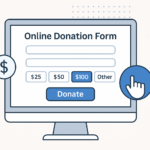Your Online Donation Form Needs to Mirror Best Practices

In today’s digital-first world, your online donation form isn’t just a transaction tool—it’s a critical moment of engagement. It can be the difference between a one-time visitor and a lifelong donor. Whether you’re launching a campaign, responding to a crisis, or collecting regular gifts, the design and function of your donation form can dramatically impact your fundraising results.
Here are the top 10 best practices to ensure your charity’s online donation form is effective, trustworthy, and donor-friendly:
1. Keep the Donation Form Simple and Focused
Less is more. Avoid overwhelming donors with too many fields, distractions, or content. Stick to the essentials:
- Name and contact information
- Donation amount
- Payment details
Tip: Every extra field you add can reduce conversion rates. Only ask for what’s necessary.
2. Offer Pre-Set Giving Amounts (With an Open Field)
Suggested donation amounts help guide donors and can increase average gifts. Include:
- 3–5 suggested amounts (e.g., $25, $50, $100, $250)
- A custom “Other” field for flexibility
Tip: Use psychologically tested values like $47 or $97 instead of round numbers—these can outperform standard amounts.
3. Highlight the Impact of Each Gift
Connect the donation to real-world outcomes:
- “$50 feeds a child for a week”
- “$100 supports a mental health workshop for 10 people”
Tip: Use icons or micro-stories to visually reinforce impact alongside gift amounts.
4. Optimise for Mobile Devices
More than half of donors will visit your site on a phone or tablet. If your form isn’t mobile-friendly, you’re losing donations.
Tip: Use responsive design, large buttons, and minimal scrolling to create a smooth mobile experience.
5. Offer Recurring Giving Options
Make monthly giving the default (but optional). Recurring donors give more over time and are easier to retain.
Tip: Frame recurring giving as a way to “make a bigger impact” or “become a monthly hero.”
6. Minimise Clicks and Page Loads
Every extra click or page load increases the risk of donor abandonment. Keep your donation form on a single page when possible.
Tip: Embed the form directly into your campaign landing page for a seamless user experience.
7. Provide Multiple Payment Options
Offer a range of secure payment methods to meet donor preferences:
- Credit/debit card
- PayPal
- Apple Pay or Google Pay
- Direct debit (especially in Australia)
Tip: Consider emerging options like digital wallets or cryptocurrency if relevant to your donor base.
8. Use Trust Signals and Security Indicators
Donors need to know their information is safe. Include:
- SSL certificate (https://)
- Lock icons or badges (e.g., PCI compliance, trusted payment processors)
- Testimonials or seals from watchdog groups
Tip: A short sentence like “This form is secure and encrypted” builds confidence.
9. Brand It Consistently
Your donation form should feel like part of your website—not a generic third-party tool. Use your:
- Logo
- Colours
- Tone of voice
- Imagery
Tip: Keep branding consistent to maintain trust and reinforce identity.
10. Say Thank You (and Mean It)
Once a donation is made, redirect donors to a personalised thank-you page. Follow up with a confirmation email that:
- Thanks them sincerely
- Confirms the amount
- Reaffirms the impact of their gift
- Offers a next step (e.g., share on social, sign up for updates)
Tip: Include a photo or short video from someone who benefits from the donor’s support.
Bonus: Test and Improve
Always be testing. Use A/B testing to improve:
- Button colours
- Suggested amounts
- Impact messages
- Form field order
Tip: Track conversion rates, bounce rates, and abandonment points with Google Analytics or Hotjar.
Final Thought
Your online donation form is more than a payment gateway—it’s a trust-building, mission-advancing moment. By following these best practices, you make it easier for people to say yes to your cause—and more likely they’ll come back again.
Let your donation form reflect the passion, professionalism, and purpose of your organisation. A better form means a better donor experience—and better outcomes for the people you serve.
